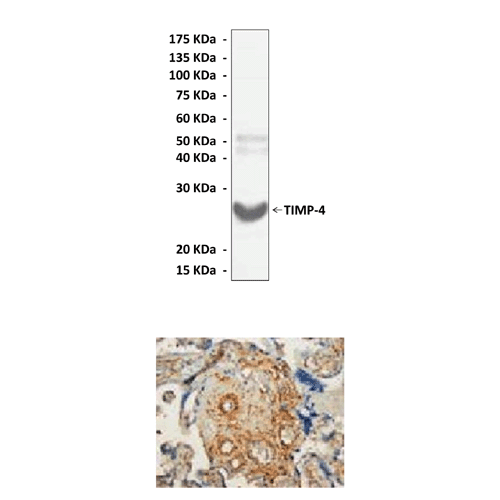Product Sheet CA0578
Description
BACKGROUND The TIMPs are well-studied inhibitors of MMPs and consist of a family of four structurally related proteins (TIMP-1–4), with core proteins of ∼21 kDa. TIMPs inhibit MMP activity by a common mechanism involving interaction of the amino-terminal cysteine residue with the zinc atom at the MMP active site. The TIMPs inhibit MMP activity associated with tumor invasion and angiogenesis. In addition to their MMP-inhibitory activity, it is now widely appreciated that TIMPs have direct effects on cellular behaviors such as cell growth, apoptosis, migration, and differentiation.1
TIMP-4 is a 195 amino acid polypeptide with molecular mass of 22 kDa. The TIMP-4 polypeptide is 37% identical to TIMP-1 and 51% identical to TIMP-2 and –3. TIMP-4 is the most neutral TIMP protein under physiological conditions (pH 7.4), having an isoelectric point of 7.34, compared with values of 8.00, 6.45 and 9.04 for human TIMP-1, TIMP-2 and TIMP-3, respectively. The TIMP-4 gene is transcribed into 1.4 kb mRNA species. Of the calcified tissues, TIMP-4 has been detected in human cartilage. TIMP-4 differs from the other three TIMPs by its restricted expression pattern. TIMP4 is characterized by being primarily restricted to cardiovascular structures and ovary. It was suggested that that TIMP-4 plays a role in the normal physiology of the heart and the ovary, most likely related to maintenance of the delicate balance between MMPs and TIMPs. Moreover, it can inhibit smooth muscle cell migration and induce apoptosis in vitro and in vivo.2 Animal studies have suggested a role for TIMP4 in several inflammatory diseases and cardiovascular pathologies. TIMP4 was most clearly visible in cardiovascular tissue areas populated by abundant inflammatory cells, mainly macrophages and CD3+ T cells. Human blood derived lymphocytes, monocytes/macrophages and mast cells were shown to produce TIMP4. In advanced atherosclerotic lesions, TIMP4 was detected around necrotic lipid cores, whereas TIMP3 and caspase 3 resided within and around the core regions, indicating different roles for TIMP3 and TIMP4 in inflammation-induced apoptosis and in matrix turnover. TIMP-4 may be a novel systemic marker for vascular inflammation.3
TIMP-4 is a 195 amino acid polypeptide with molecular mass of 22 kDa. The TIMP-4 polypeptide is 37% identical to TIMP-1 and 51% identical to TIMP-2 and –3. TIMP-4 is the most neutral TIMP protein under physiological conditions (pH 7.4), having an isoelectric point of 7.34, compared with values of 8.00, 6.45 and 9.04 for human TIMP-1, TIMP-2 and TIMP-3, respectively. The TIMP-4 gene is transcribed into 1.4 kb mRNA species. Of the calcified tissues, TIMP-4 has been detected in human cartilage. TIMP-4 differs from the other three TIMPs by its restricted expression pattern. TIMP4 is characterized by being primarily restricted to cardiovascular structures and ovary. It was suggested that that TIMP-4 plays a role in the normal physiology of the heart and the ovary, most likely related to maintenance of the delicate balance between MMPs and TIMPs. Moreover, it can inhibit smooth muscle cell migration and induce apoptosis in vitro and in vivo.2 Animal studies have suggested a role for TIMP4 in several inflammatory diseases and cardiovascular pathologies. TIMP4 was most clearly visible in cardiovascular tissue areas populated by abundant inflammatory cells, mainly macrophages and CD3+ T cells. Human blood derived lymphocytes, monocytes/macrophages and mast cells were shown to produce TIMP4. In advanced atherosclerotic lesions, TIMP4 was detected around necrotic lipid cores, whereas TIMP3 and caspase 3 resided within and around the core regions, indicating different roles for TIMP3 and TIMP4 in inflammation-induced apoptosis and in matrix turnover. TIMP-4 may be a novel systemic marker for vascular inflammation.3
REFERENCES
1. Gomez, D.E.: Eur J Cell Biol. 74:111-22, 1997
2. Guo, Y.H. et al: Life Sci. 75:2483-93, 2004
3. Koskivirta, I. et al: Histochem. Cell Biol. 126:335-42, 2006
2. Guo, Y.H. et al: Life Sci. 75:2483-93, 2004
3. Koskivirta, I. et al: Histochem. Cell Biol. 126:335-42, 2006
Products are for research use only. They are not intended for human, animal, or diagnostic applications.
Details
Cat.No.: | CA0578 |
Antigen: | C- terminal sequence of human TIMP-4 |
Isotype: | Affinity-purified rabbit polyclonal IgG |
Species & predicted species cross- reactivity ( ): | Human, Rat, Mouse |
Applications & Suggested starting dilutions:* | WB 1:500 - 1:1000 IP n/d IHC (Paraffin) 1:50 - 1:200 ICC n/d FACS n/d |
Predicted Molecular Weight of protein: | 26 kDa |
Specificity/Sensitivity: | Reacts specifically with TIMP-4 of human, mouse, and rat origin in immunohistochemical staining and western blotting, no cross-reactivity with other members of the family. |
Storage: | Store at 4° C for frequent use; at -20° C for at least one year. |
*Optimal working dilutions must be determined by end user.
Products
| Product | Size | CAT.# | Price | Quantity |
|---|---|---|---|---|
| Polyclonal Tissue Inhibitors of Metalloproteinases-4 Antibody: Polyclonal Tissue Inhibitors of Metalloproteinases-4 Antibody | Size: 100 ul | CAT.#: CA0578 | Price: $375.00 |

